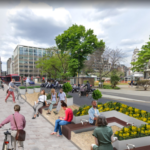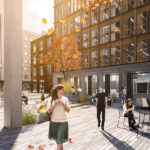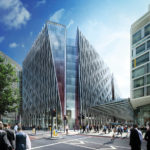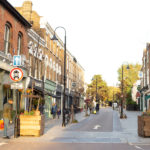As we come out of one of the wettest springs and straight into what has been verified as the hottest June on record in the UK, it’s more important than ever to consider the role that good public realm can – and must – play in managing climate change.
Extreme weather, including flooding, is expected to increase in the coming years. Met Office statistics have reported that England and Wales had its wettest March in over 40 years this year. The future trends also suggest at more fluctuations and variations in rainfall, both across the seasons and UK regions. For instance, climate predictions indicate that rainfall intensity in the summer, in addition to the winter, is likely to be higher than what we experience today.
This puts immense pressure on existing infrastructure to effectively manage and respond to such extreme weather events. And climate and flooding resilience need to be at the forefront of urban planning. Good public realm design practice considers how we can navigate these challenges and the integration of green infrastructure will be key to this, none more so than sustainable urban drainage systems (SuDS). These provide a natural and sustainable approach to managing rainfall and flooding. SuDS can come in many forms, including:
- Rain gardens (green roofs, vertical walls)
- Tree planting systems, including the role of tree canopies in not only capturing rainfall during wet events but also providing shade during hot days
- Permeable paving systems
These solutions all help to maximise the benefits of rainfall and support the natural water cycle, while providing mitigation during extreme weather events. In addition, greening the urban realm provides outdoor spaces for the wellbeing of both people and ecosystems to flourish. They can play a key role in providing public realm spaces which draw people in, resulting in thriving local businesses and communities. The need for greening is recognised nationwide, with significant funding available from the likes of the National Environment Readiness Fund and local boroughs implementing greening strategies and initiatives across their areas.
As part of this, engineers need to move away from the – often easier and historic – route of hard landscaping. The engagement of local communities is also an important consideration in the implementation of SuDS. Giving people a sense of ownership over their local developments will help these areas to thrive in the future, with locals taking pride in maintaining their assets. Consideration of communities is more prevalent than ever with growing and ageing populations to consider.
Striking the balance between ‘place’ and ‘movement’ will also be a vital consideration for how greening dovetails into public realm schemes. A final challenge will be adapting these SuDS systems to existing infrastructure, most notably the cluttered and congested underground apparatus and utilities which are widespread in urban environments.
Overcoming these challenges will greatly help in navigating how the built environment is shaped, and in ensuring that green infrastructure is at the forefront of our urban planning and public realm. This will allow the likes of SuDS and greening to play their key and necessary role as we move towards a more climate-resilient future.







